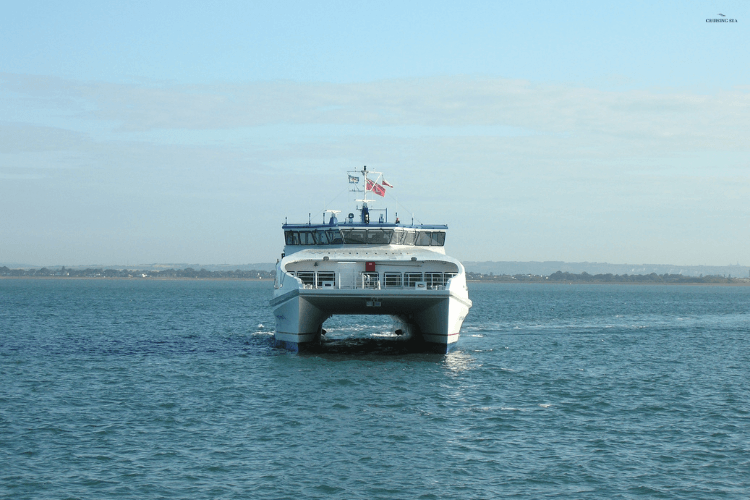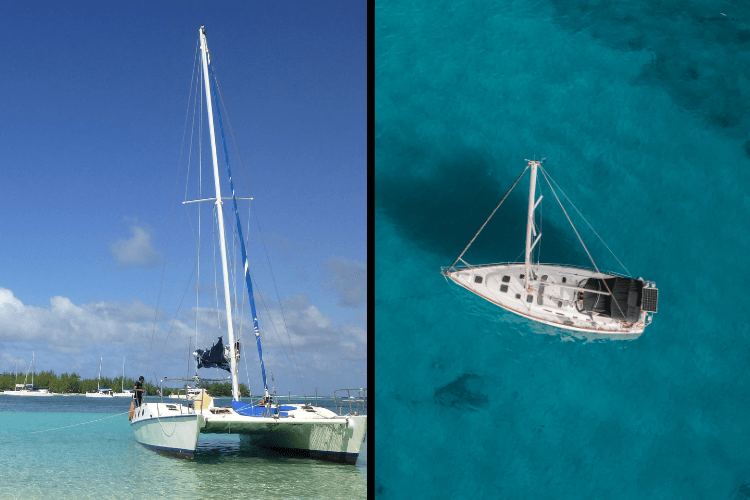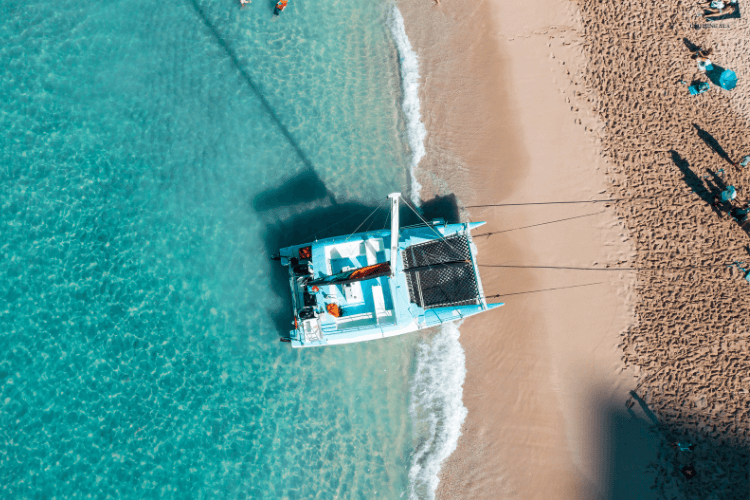If you’re planning a sailing trip on a catamaran, you might be wondering, “Do catamarans cause seasickness?” And if you’re someone who’s prone to motion sickness, this is a valid concern.
After all, seasickness can be incredibly uncomfortable and ruin your fun excursion on the water. Well, fear not because today I’ll dive into the intriguing world of catamarans and their impact on seasickness.
Whether you’re a seasoned sailor or a curious adventurer, understanding the relationship between catamarans and seasickness is key to ensuring your nautical journeys are as smooth as possible.
Key Takeaways
- Catamarans are designed with two parallel hulls, providing stability and a smoother ride.
- The unique anatomy of catamarans can help reduce seasickness compared to monohull boats.
- Preventing seasickness aboard a catamaran can also rely on factors such as sailing conditions and personal experience.
Understanding Catamarans Design

When you think of a catamaran, you might imagine a sleek, fast vessel with two hulls gracefully cutting through the water. But what exactly goes into the design of these multi-hull vessels, and what benefits do they provide? Let’s see the anatomy of catamarans to help you understand their unique characteristics and how they could impact seasickness.
To start with, as mentioned, a catamaran is a multi-hull vessel featuring two parallel hulls. These twin hulls provide excellent stability and buoyancy, allowing the catamaran to have a shallower draft than traditional monohull vessels.
As a result, they are able to access shallow water areas, which can be a big advantage in certain situations.
The deck of a catamaran connects the two hulls, providing a spacious, open area for lounging, entertaining, and enjoying the water.
Many catamarans also feature a covered cockpit area, which can serve as a comfortable space for navigation and steering, protected from sun and rain.
Speaking of steering, catamarans are typically equipped with twin engines – one in each hull. This dual-engine setup not only offers more horsepower for speed and maneuverability but also adds redundancy, making it less likely that you’ll get stuck due to an engine failure.
Now, let’s talk about the unique sensation of being on a catamaran. The design of these vessels leads to a more stable, level ride compared to monohulls.
While they still move with the waves, their wide beam helps them resist heeling (leaning to one side), and their twin hulls create a different motion pattern than a single-hull vessel.
This can be a contributing factor in how seasickness affects individuals on board.
Understanding Sea Sickness
Sea sickness, also known as motion sickness, is a common issue experienced by many travelers. It’s especially common among those who spend time on boats, such as a catamaran.
You might be wondering why this happens and what causes these uncomfortable symptoms. Let’s dive into the underlying causes and science behind sea sickness.
Seasickness is a form of motion sickness characterized by feelings of nausea, vomiting, dizziness, pale skin, cold sweat, and even anxiety. It occurs when your body’s sensory systems receive conflicting messages about motion.
Your inner ear, eyes, and central nervous system all play a role in maintaining balance and transmitting information about your body’s position in space.
When you’re on an underway boat, the constant motion can create a mismatch between what your eyes see and what your inner ear senses.
For example, your eyes may perceive a stable horizon, while your inner ear detects the up-and-down or side-to-side motion of the boat. This discrepancy can confuse your brain and lead to the symptoms of seasickness.
Keep in mind that not everyone experiences seasickness to the same degree. Some people have a higher tolerance to motion, while others are more susceptible to its effects.
This can depend on factors such as your personal experiences, genetics, or even the conditions on the boat or ocean at the time.
While sea sickness can be pretty unpleasant and, in some cases, debilitating, there are ways to manage or even prevent it. See how to avoid seasickness in the chapter below.
Monohulls Vs. Catamarans – Which Has Less Impact On Seasickness?

When it comes to sailing, you might wonder whether monohulls or catamarans are more likely to cause seasickness. So, let’s compare the two types of boats and discuss their impact on motion sickness.
Monohulls typically have a more pronounced roll behavior, which means they tend to tilt from side to side more than catamarans. This higher degree of roll can contribute to a higher likelihood of seasickness in people who are prone to it.
Monohulls also experience more yaw, side-to-side movement, and pitch, which is a boat’s movement up and down in the water. These motions can make the ride less comfortable for some passengers.
On the other hand, catamarans generally provide a more stable ride due to their two-hull design. This design reduces rolling, yawing, and pitching compared to monohulls. As a result, passengers on catamarans are less likely to experience seasickness.
A crucial factor impacting seasickness is the vertical acceleration experienced on a boat. Catamarans tend to have lower vertical acceleration levels, making their movements gentler and more predictable. This reduced acceleration can also help prevent motion sickness.
In summary, while both monohulls and catamarans can cause seasickness in some passengers, catamarans are generally considered the more stable option. With their reduced roll, yaw, and pitch and gentler vertical acceleration, catamarans might be the better choice if prone to motion sickness.
How Catamarans Influence Seasickness
When planning your next sailing adventure, you might be wondering if catamarans cause seasickness. The good news is that, in general, catamarans offer a more comfortable and smoother ride compared to monohull boats.
This is due to their wider beam and reduced heeling, which provide greater stability and predictability. So, let’s dive a little deeper into how catamarans can influence seasickness and make your experience on the water more enjoyable.
The design of catamarans plays a significant role in providing a smoother ride. With their twin hulls and wide beam, they tend to have less rolling motion in the water. This can help minimize the occurrences of seasickness for you and your passengers.
In fact, a survey conducted among sailors has shown that people who are susceptible to motion sickness are generally less likely to get sick on catamarans than on monohull ships.
Another important aspect of catamarans that contributes to passenger comfort is their predictability. The gentler and more stable motion of catamarans can help you anticipate the boat’s movement, allowing you to better adapt and avoid feeling nauseous.
However, it’s essential to remember that seasickness varies from person to person, and while a catamaran may provide a smoother ride for some, others may still experience discomfort.
The Impact of Sailing Conditions on Seasickness
Sailing conditions can have a significant impact on how you feel about the water. Weather, waves, and even the type of vessel you’re on can contribute to the onset of sea sickness.
When you embark on a sailing trip, the waves and motion of the water play a crucial role in your overall experience.
Rough seas can exacerbate feelings of drowsiness and nausea, which are common symptoms of sea sickness.
Sailing in calm waters, on the other hand, can make a world of difference in keeping those unpleasant sensations at bay.
One thing that sets catamarans apart from other vessels is their stability.
Thanks to their twin-hull design, catamarans experience less yawing motion than traditional monohull boats, which can ultimately reduce the chances of sea sickness.
However, this doesn’t mean that they are immune to it. It’s still possible to feel sick, especially if you’re sensitive to motion.
Catamarans offer a more stable experience, which often helps reduce the risk of sea sickness. However, you should always be prepared and take some seasickness prevention before you get on board.
6 Useful Tips To Prevent Sea Sickness
If you are worried about sea sickness aboard a catamaran, don’t worry. There are various ways to avoid or reduce the risk of experiencing this uncomfortable feeling. Here are some helpful tips for preventing seasickness while enjoying your time on a catamaran.
1 Firstly, pay attention to what you eat and drink before and during the trip. Don’t drink alcohol, as it can worsen the effects of sea sickness. Instead, stay hydrated by drinking enough water.
2. Opt for foods that are easy to digest, avoiding heavy, greasy, or spicy food.
3 Taking medications such as Dramamine, antihistamines, Stugeron, Meclizine, and Dimenhydrinate can also be helpful. Don’t forget to speak to your doctor before taking any medicines, especially if you have any pre-existing medical conditions.
4 One of the most effective ways to avoid seasickness is by getting plenty of fresh air. Catamarans often offer better ventilation than monohulls, making them a more comfortable option. Sit in a spot where you can breathe fresh air, as this will help reduce any feelings of nausea.
5. Also, ensure you get enough sleep before embarking on your catamaran adventure. Being well-rested can help minimize the chances of experiencing seasickness. If possible, find a spot on the catamaran where you can rest comfortably, away from any strong odors or fumes.
6 . One popular remedy is ginger tea, known for its anti-nausea properties. Sipping on ginger tea while aboard your catamaran can help soothe your stomach and make your sailing experience more enjoyable.
Frequently Asked Questions
Q: How do catamarans compare to monohulls for motion sickness?
Catamarans typically offer a smoother ride than monohulls, which helps reduce the risk of motion sickness. This is due to their twin-hull design providing better stability and reduced rocking motion. However, first-time riders may still experience discomfort if they lack sufficient boating experience.
Q: What measures can be taken to avoid seasickness on a catamaran?
To avoid seasickness, try to keep your eyes on the horizon, as this can help you maintain balance. Fresh air and proper ventilation onboard also play a role in reducing uneasiness. Additionally, avoid heavy meals before setting sail and consider using over-the-counter medication, ginger, or acupressure wristbands to tackle motion sickness effectively.
Q: Is it easier to get seasick on catamarans or other types of boats?
While catamarans offer a more stable and smoother ride than many other types of boats—which helps mitigate seasickness—they might not always prevent it entirely. Seasickness varies from person to person, but generally, the risk is lower on catamarans when compared to monohulls.
Q: Are catamarans stable in rough seas?
Catamarans have a reputation for being stable in rough seas due to their wider beam and twin-hull design. They typically experience less heeling and rolling than monohulls, which can make for a more comfortable experience. However, it’s crucial to keep in mind that no boat is entirely immune to adverse weather conditions.
Q: Which part of a catamaran is the best area to minimize motion sickness?
To minimize motion sickness, it’s best to choose a spot near the center of the catamaran, as this area experiences the least amount of motion. As a general rule, the closer you are to the waterline and the center of the boat, the less motion you will feel.
Q: How do hull designs affect seasickness on catamarans?
Hull designs play a significant role in a vessel’s stability and motion. Since catamarans have two hulls, they create a wider and more stable platform than single-hulled boats. This design reduces rocking and rolling motions that often contribute to seasickness, making catamarans generally more comfortable for those prone to motion sickness.
Final Words
In conclusion, catamarans can potentially reduce the risk of seasickness due to their smoother ride compared to monohull boats. However, some people may still experience motion sickness on a catamaran, and there are a variety of factors that can influence how prone someone is to seasickness.
To mitigate seasickness, there are several tips and tricks you can try, such as the ones listed above. Additionally, it can help to gradually acclimate yourself to the motion of the catamaran by spending time onboard before venturing out on longer journeys.
Want More Tips?
Subscribe to Cruising Sea newsletter to receive every two-week the latest post straight to your inbox

Daniella has been passionate about travel, the sea, and nature for many years. As a child, she frequently traveled throughout the Mediterranean and continued with her journeys throughout her adult life.
Her experiences have created the desire within her to share her love for traveling with other passionate and adventurers who want to discover beautiful horizons and new cultures.


I just finished a webinar with a travel supplier that offered cruises for single families on catamarans in the sea waters off the shores of Croatia. It’s interesting to me about the twin hulls providing stabilization and lessening the effect of the moving waves on seasickness. If the catamaran is larger in size, does that lessen the effect of the sea motion on causing seasickness? Approximately, how large would the catamaran vessel be to take a family of four with just captain and first mate on a cruise just in the bay area off the shore of Croatia? The information you provided here will be invaluable to know and convey to any potential future clients that may be interested in taking these tours. Thanks for your informative article.
Hi Delois,
To answer your question, yes, the size of the catamaran does play a role in stabilizing the ride, as larger vessels tend to handle waves more smoothly than smaller ones.
For a family of four, along with a captain and a first mate, a mid-sized catamaran ranging from 40 to 50 feet in length should provide a comfortable and stable cruising experience in the bay area off the shore of Croatia. This will be enough spacious to allow you to have an enjoyable journey for everyone on board.
I’m glad you found this information valuable, and I’m sure your potential clients will, too! If you have any more questions or if there’s anything else I can help you with, feel free to ask.
Thank you for the comment, and I wish you a wonderful day.
I was in the navy but I have never been at sea because of the specific job that I had at the time, but a few of my buddies that actually went to sea told me a lot about sea sickness. How they explained it, it sounds very similar to being carsick, which I have been before. I didn’t know that certain types of boats or ships can cause different levels or types of sea sickness. This post is awesome.
Hello there!
I’m glad to hear that you found the post awesome! Your buddies were absolutely right – sea sickness can indeed feel a lot like being carsick. It’s fascinating how our bodies react to motion, isn’t it? And you’re spot on – the type of boat or ship can definitely affect how severe seasickness might be. Thanks for sharing your experience, and if you ever have more questions, feel free to reach out.
Thank you for the comment and I wish you a great day!